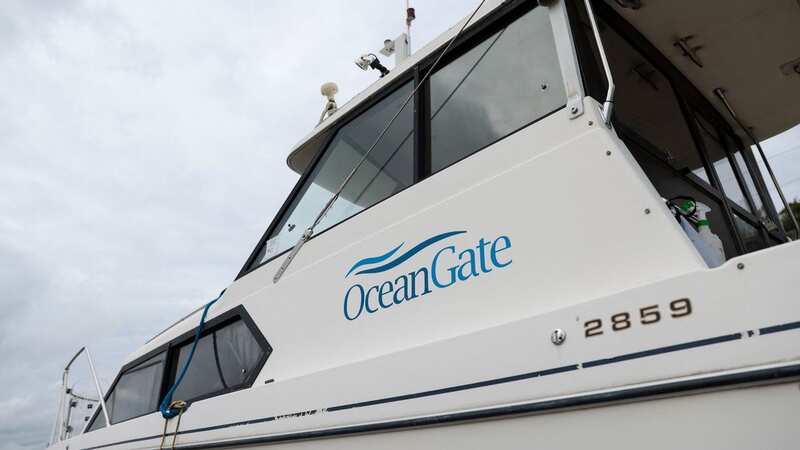

The firm behind the submersible which imploded on an expedition to the wreckage of the Titanic appears to be trying to scrub itself from existence on the internet, with its website down and social media accounts purged.
The OceanGate Titan was on a journey to the wreckage of the Titanic, off the coast of Newfoundland, Canada, when it lost communication with its mother ship, Polar Prince, less than two hours into its descent on Sunday, June 18. A huge search effort was launched, with multiple agencies from across the world collaborating in an attempt to find the missing sub and its five passengers.
However, the Coast Guard later confirmed that the sub had suffered a catastrophic implosion, instantly killing those on board. Among the passengers on the sub was OceanGate's CEO, Stockton Rush, who was piloting the sub's journey 12,500 feet below the ocean's surface.
Now, the company seems to be trying to erase itself from the internet. As of Friday morning, July 14, OceanGate's website went dark. Visitors to the site are now met with a black screen bearing the company's logo and a short message.
"OceanGate Expeditions has suspended all exploration and commercial operations."
 Jake Paul calls on John Fury to make retirement bet for fight with son Tommy
Jake Paul calls on John Fury to make retirement bet for fight with son Tommy
 Stockton Rush (left) co-founded OceanGate in 2009 and served as the company’s CEO until he died in a “catastrophic implosion” along with the four other passengers on board the Titan sub (AP)
Stockton Rush (left) co-founded OceanGate in 2009 and served as the company’s CEO until he died in a “catastrophic implosion” along with the four other passengers on board the Titan sub (AP)It's unclear exactly when the website was updated to remove content about its eight-day submersible trips to the historic wreckage. But the company didn't stop there, their social media sites were also unavailable to the public on Friday.
Attempts to locate the company's Facebook page are met with a message saying "This content isn't available at the moment." On Twitter, "This account doesn't exist". And on Instagram, "Sorry, this page isn't available."
Prior to the shutting down of OceanGate's website, visitors were able to navigate through and learn more about the Titanic Expedition which cost $250,000. The company was co-founded in 2009 by Mr Rush and Guillermo Söhnlein, an Argentine-American businessman who left OceanGate in 2013.
Mr Rush was piloting the sub when it suffered the "catastrophic implosion" which killed him and the four other passengers: British billionaire explorer Hamish Harding, 58, Pakistani businessman Shahzada Dawood, 48, and his son Suleman Dawood, 19, and French Titanic expert Paul-Henri Nargeolet, 77.
 OceanGate's Instagram remained online for a while but was set to private before being seemingly deleted (Instagram/@oceangate)
OceanGate's Instagram remained online for a while but was set to private before being seemingly deleted (Instagram/@oceangate)Since the ill-fated expedition, it has emerged from a would-be passenger that Mr Rush wasn't actually interested in tourism, he simply needed to fund his obsession with the Titanic. This came from Las Vegas financier Jay Bloom, who pulled out of the voyage due to safety concerns.
Speaking to the New York Post, he said: "[Rush] wasn't really looking to build a tourism business to the Titanic. He wanted to research and document the decay of the ship over time."
He added: "Multiple dives to the site costs a lot of money. A way to finance his scientific observation was to bring observers down with him."
With space for five people in the Titan, Mr Rush was earning $1 million per trip - though it's unclear how much money it took to operate Titan. However, Mr Rush appeared strapped for cash, and reportedly used carbon fibre to construct the sub from a plane which was past its shelf life for use in aviation.
 OceanGate has come under fierce criticism after the doomed voyage (AFP via Getty Images)
OceanGate has come under fierce criticism after the doomed voyage (AFP via Getty Images)A chilling video which became a YouTube sensation showed exactly how the submersible imploded. The video details the horrifying implosion, and how and why the sub collapsed in on itself due to the immense pressure of being so deep underwater.
The animation from AiTelly uses an open-source software called Blender to show how the "experimental design" of the Titan submersible was different to existing sub technology - which uses steel, titanium and aluminium. It took those behind the YouTube channel 12 hours to plug in all the data about OceanGate into the 3D modelling software to allow them to create the dynamic animation for viewers.
 Tommy Fury 'moves out' of mansion shared with Molly-Mae ahead of Jake Paul fight
Tommy Fury 'moves out' of mansion shared with Molly-Mae ahead of Jake Paul fight
Experts have said that the ultimate problem was the Titan's carbon fibre construction. The material is known for its ability to "crack and break suddenly".
At the depth of the Titanic wreck, there is around 5,600 psi (pounds per square inch) of pressure - almost 400 times the pressure we feel on the surface.
The voiceover on the YouTube video says: "The submersible did not even reach the wreckage of the Titanic, but suffered a catastrophic implosion because of the weak carbon fibre hull."
10 days after communication was lost, human remains were recovered from the wreckage of the Titan sub which was brought ashore in St John's, Newfoundland. Experts have shared what the final moments of those on board may have been, saying it "would be like a horror movie".